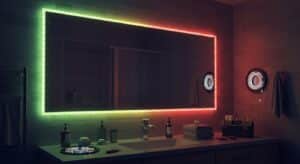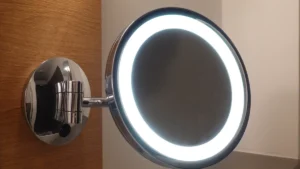
Choosing the right LED strip channel saves energy and lasts long. It makes LED strip lights work better and last longer. It also makes the lights look more attractive. Think about where and how you will use it to decide. A good channel improves LED performance and looks nice too.
Key Takeaways
Pick the correct channel size for your LED strip. A good fit improves how it works and looks.
Choose a diffuser type that suits your lighting needs. Frosted ones give soft light, while clear ones are brighter.
Use aluminium channels for better heat control and strength. They make LEDs last longer and work well.
Key Factors for Picking the Best LED Strip Channel
LED Strip Width and Fit
Start by checking if the channel fits your LED strip. If it doesn’t fit, the lights won’t work well or look good. Measure your LED strip’s width carefully. Pick a channel that fits it properly. A channel that’s too small can harm the strip. A channel that’s too big spreads light poorly.
For indoor use, choose channels that make lights brighter and colours better. For outdoor use, pick snug channels to protect from water and dust.
Diffuser Type and Light Spread
The diffuser decides how the light looks. Frosted diffusers make soft, even light, great for cosy spaces. Clear diffusers make bright light, perfect for work areas.
Pick a diffuser based on how you want the light to look and work. For example, frosted diffusers are good for under-cabinet lights. Clear ones are better for workspaces where you need bright light.
Heat Control and Material Choice
Managing heat helps LED strips last longer. Aluminium channels pull heat away from the LEDs. This stops them from getting too hot and breaking.
Plastic channels work for low-power LEDs. But aluminium is better for stronger lights. It’s tough and keeps LEDs cool, making it great for saving energy.
Installation Style and Mounting Choices
Different channels suit different setups. Surface-mounted channels are simple to put up and good for accents. Recessed channels hide in surfaces, perfect for ceilings or stairs. Corner channels aim light well, great for art or special features.
Flexible channels bend to fit curves, ideal for creative designs. Pick a channel type that matches your space and needs.
Channel Type | What It Does | Where to Use It | Fun Ideas |
|---|---|---|---|
Surface-Mounted | Sticks onto surfaces, easy to set up. | Under shelves, for accents, or in coves. | Soft glow around mirrors, highlight cool designs. |
Recessed | Fits into surfaces for a smooth look. | Ceilings, stairs, or hidden lighting. | Long light lines on ceilings, outdoor patios. |
Corner | Made for corners, shines light exactly where needed. | Show off art or shop displays. | Cool effects in hallways or shop windows. |
Flexible | Bends to fit curves and odd shapes. | Fun designs in themed spaces. | Wrap around poles or light up wavy shapes in gardens. |
Application-Specific Tips for LED Strip Lights
Indoor Uses (e.g., Kitchen, Ceiling Lighting)
LED strip lights are great for indoor lighting needs. In kitchens, under-cabinet lights brighten countertops for easy cooking. Ceiling channels add soft light to living rooms, making them cosy.
Pick a channel based on how bright you want the light. Frosted covers spread light evenly, while clear ones make it brighter. Make sure the channel fits well to stop light leaks and keep it neat.
Outdoor Uses and Waterproof Channels
For outdoor spaces, use strong, waterproof LED channels. These protect lights from rain, dust, and dirt. They work well for lighting decks or paths, adding safety and style.
Choose channels made for outdoor use with good seals. Aluminium channels are strong and keep lights cool. Install them properly to ensure they last and save energy.
Task Lighting for Work Areas and Kitchens
Task lighting needs bright, focused light for detailed work. LED strips are perfect for kitchens and workspaces where clarity matters. Use ceiling or under-cabinet channels for the best brightness.
For tasks, pick channels with clear covers to make lights brighter. This keeps your workspace bright, reduces eye strain, and helps you work better.
Accent Lighting for Decoration
Accent lighting makes art, designs, or room features stand out. Frosted covers give a soft glow, making rooms look stylish. Flexible channels let you shape lights for unique designs.
For accent lighting, slim channels look neat and modern. Good diffusion makes the light smooth and even, adding beauty to your space.
Material and Design Considerations for LED Strip Channels
Aluminium Channels for Heat Control and Strength
Aluminium channels help control heat in LED strip lights. They pull heat away, stopping the LEDs from overheating. This keeps the lights working well and lasting longer. Aluminium is great at spreading heat, with a thermal range of 200 to 215 W/mK.
Aluminium is also strong and long-lasting. It doesn’t rust and handles humidity and temperature changes well. This makes it perfect for kitchens or outdoor paths. Aluminium channels give strong support for long-term use.
Material | Heat Control | Strength | Cost |
|---|---|---|---|
Aluminium | Excellent | High | Medium |
Plastic | Okay | Moderate | Low |
Frosted vs. Clear Covers for Light Spread
The cover you pick changes how the light looks. Frosted covers spread light softly, making a warm and cosy glow. These are great for living rooms or bedrooms. Clear covers make light bright, perfect for kitchens or workspaces.
Think about what you need the light for when choosing. Frosted covers look nice, while clear ones are better for bright tasks. Both can make your LED lights work well for different needs.
Slim vs. Wide Profiles for Style and Light Needs
The shape of the LED channel affects its look and use. Slim channels look modern and fit well in simple designs. They are good for soft accent lighting. Wide channels spread light better and work for brighter spaces like under cabinets.
Decide based on your style and light needs. Slim channels are subtle, while wide ones give more light for bigger spaces.
Picking the right LED strip channel saves energy and looks good. It keeps LED strips safe, spreads heat well, and makes light even. It also gives a neat and tidy finish. Think about where to use it, the material, and how to install it. This way, your lighting will be smart and stylish.
FAQ
What does “lumens per foot” mean in LED strip lighting?
It shows how bright the LED strip is. More lumens per foot mean brighter light, good for work or big areas.
Are there any tips for installation of LED strip channels?
Clean the surface before starting. Measure carefully and fix the channel tightly. This stops light from leaking and makes it last longer.
Why is proper installation important for LED strip channels?
It helps the lights work their best and saves energy. It also keeps the lights safe and makes them look neat.
See Also
Selecting The Perfect LED Strip Lights For Linear Lighting
Deciding On The Best LED Strips: 2835, 3528, Or 5050
Utilising Smart LED Strips For Home Lighting Solutions In 2025
Comparative Analysis Of High-Brightness LED Strips For All Uses
Choosing The Ideal RGB LED Strip To Suit Your Requirements



